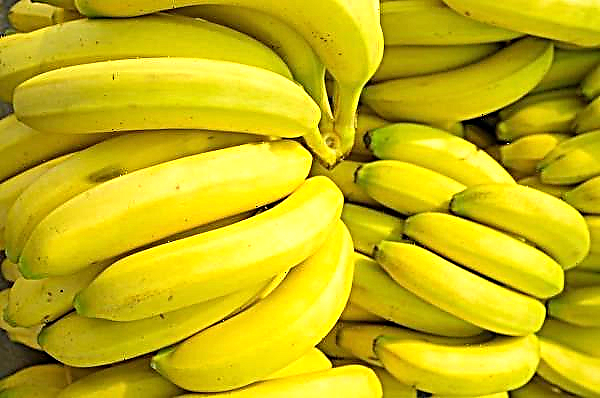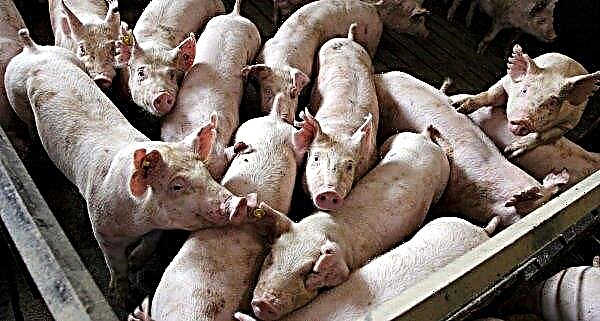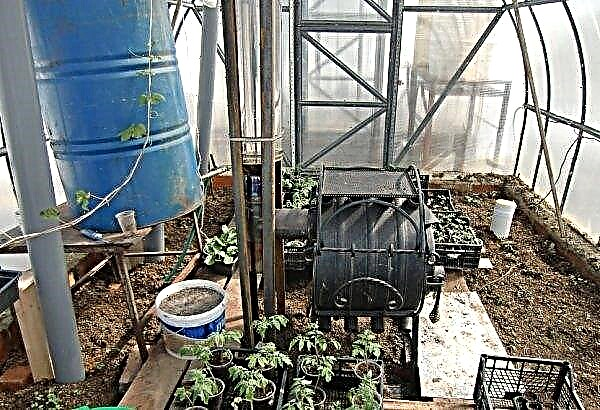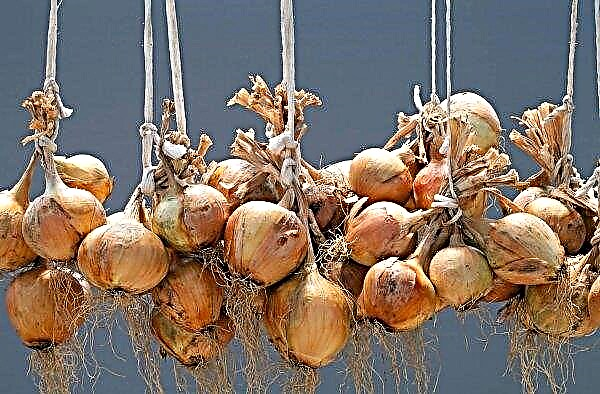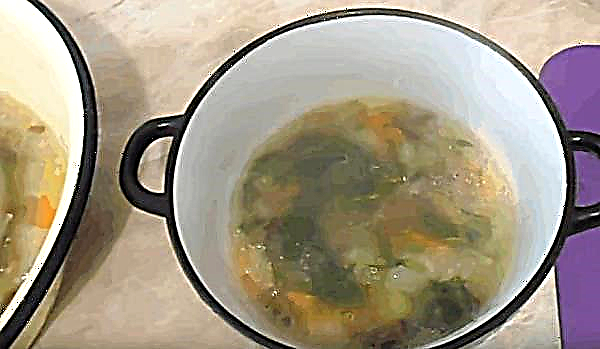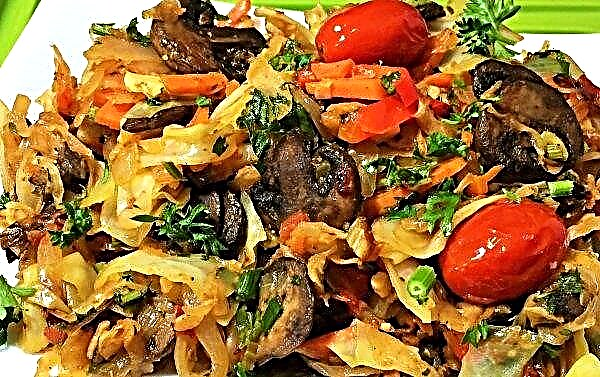The most common problems encountered by simple summer residents and large farms that grow melons are all kinds of pests and infectious diseases of the culture. There are many reasons for the appearance of parasites, bacterial and fungal infestations, but not every farmer knows how to deal with such a threat. The article will examine in detail the most dangerous pests and diseases of melon, and also describe how to overcome and prevent their occurrence.
The most common melon diseases
All sorts of melons are an excellent breeding ground for bacteria and fungi. Their flesh has the necessary moisture level and a whole complex of nutrients that creates ideal conditions for the growth and reproduction of microorganisms. However, not each of them poses a threat to plantations, therefore, the most dangerous and characteristic diseases for melon and other melons and gourds will be considered below.
Did you know? The largest melon in the world was grown in Austria in 2009. The local farmer managed to get a giant fruit weighing 447 kg.
Fusarium wilt
Fusarium wilt is commonly understood as a complex infectious disease caused by fungi from the Fusarium genus. It is most often found in mid-season and late varieties of melon, but under favorable conditions it can also affect early melons. As a result of invasion, the quality of the fruits is deteriorated, they become less juicy, fragrant, lose their shelf life and sugar content. The source of infection is soil, water, or garden tools contaminated with spores of the pathogen. An infection occurs most often in the early stages (the first signs of a fungus can be detected already in the phase of 3 leaves) or during fruit loading. This fungal disease most often manifests itself in medium and late melons. The main signs of Fusarium wilt are considered to be the blanching of the green mass of plants, as well as the appearance of various gray spots on the stem and leaves. With untimely treatment, these foci of infection lead to drying of the melon. To overcome the disease, the beds must be sprayed with a 1% urea solution, and then carefully treated with a 1% Bordeaux mixture, Oksikhom or Topaz preparations. Perform the procedure twice with a break of 7-10 days.
This fungal disease most often manifests itself in medium and late melons. The main signs of Fusarium wilt are considered to be the blanching of the green mass of plants, as well as the appearance of various gray spots on the stem and leaves. With untimely treatment, these foci of infection lead to drying of the melon. To overcome the disease, the beds must be sprayed with a 1% urea solution, and then carefully treated with a 1% Bordeaux mixture, Oksikhom or Topaz preparations. Perform the procedure twice with a break of 7-10 days.
Important! Fusarium wilting develops rapidly, with an untimely stopping of the disease, the plantations die 1–1.5 weeks after infection.
Gray mold
Gray putrefactive plaque on a melon is a consequence of the development of a specific fungus from the genus Botritis in an imperfect stage. The microorganism in the environment is ubiquitous, so specific conditions must be created for the destruction of beds. These include a combination of low immunity, high humidity and prolonged exposure to plants at low temperatures (+10 ... + 15 ° C). Signs of gray mold development are quite characteristic. The green mass is covered with a thick grayish-white coating, while the pulp of the fruit becomes soft and watery. It is almost impossible to eliminate the infection on affected plants, so damaged bushes and fruits are cut and disposed of. After this, the beds should be treated with a mixture of 10 l of water, 10 g of urea, 2 g of copper sulphate and 1 g of zinc sulfate (per 2 m²).
Signs of gray mold development are quite characteristic. The green mass is covered with a thick grayish-white coating, while the pulp of the fruit becomes soft and watery. It is almost impossible to eliminate the infection on affected plants, so damaged bushes and fruits are cut and disposed of. After this, the beds should be treated with a mixture of 10 l of water, 10 g of urea, 2 g of copper sulphate and 1 g of zinc sulfate (per 2 m²).
Did you know? The most expensive melon in the world is the so-called Yubari King variety. The plant is grown in Japan in limited quantities, and the price for one average fruit can reach $10 thousand US
Powdery mildew
The main reason for the manifestation of powdery mildew is considered to be microscopic pathogenic fungi from the Erysiphian order. The activation of fungal spores is caused by a combination of high humidity on the site, thickened crops and sudden changes in temperature throughout the day. Sources of infection spores are considered contaminated water, soil and seeds. But they can also spread by air and water erosion. The appearance of powdery mildew in the beds can be distinguished by the characteristic pale spots on the melon leaves. Over time, they transform into a general coating, which covers the entire surface of both a single leaf and the entire green mass as a whole. In case of untimely treatment, powdery mildew leads to withering, twisting and drying of the plants, as a result of which the melons die.
The appearance of powdery mildew in the beds can be distinguished by the characteristic pale spots on the melon leaves. Over time, they transform into a general coating, which covers the entire surface of both a single leaf and the entire green mass as a whole. In case of untimely treatment, powdery mildew leads to withering, twisting and drying of the plants, as a result of which the melons die.
Important! To distinguish false powdery mildew from the present, you need to look at the nature of the defeat of the green mass. When a false fungus develops on the back of the leaves, in the case of the present, the characteristic signs of the disease appear on the upper side.
It is not difficult to overcome the manifestations of infection. To cope with the fungus, plantings should be treated with colloidal sulfur. Prepare a preparation with a calculation of about 75 g / 10 l of water, and then they carefully spray the beds twice with an interval of 7 days. Spores of the fungus are quite resistant to adverse factors, so the treatment must be repeated approximately 20-30 days before harvest, which helps protect against infection and the fruit.
Root rot
Root rot is commonly understood as focal or extensive putrefaction of the root system caused by a wide group of fungal organisms from the genera Fusarium, Rhizoctonium, Phytophthora, Diplodia, Penicillum and Pitium. The infection spreads quickly on the site and can be observed at almost any stage of melon growth. Its main reason is considered to be high humidity in the area, as well as reduced immunity of plants. Fungal spores are everywhere in the environment, so they can be found in water, soil, as well as air masses. Identifying root rot is not easy, the first sign of pathology can be called a lag in plant growth, as well as a slow withering of the stands.  If the rot developed during fruiting, the crop either does not ripen completely or rot from the inside. When examining the root system, you can see viscous putrid foci on the roots in the form of black, brown spots, as well as extensive necrosis. This leads to a slow death of plantations, if the pathology developed during the ripening of the melon, the fruits can rot from the inside. At the same time, their quality and taste characteristics are lost. In the fight against rot, first of all, humidity and irrigation system are regulated on the site. After this, the beds are sprayed twice, with an interval of 2 weeks, with 2% copper sulfate, Bordeaux mixture, or Topaz, Fundazol or Fitoflavin preparations.
If the rot developed during fruiting, the crop either does not ripen completely or rot from the inside. When examining the root system, you can see viscous putrid foci on the roots in the form of black, brown spots, as well as extensive necrosis. This leads to a slow death of plantations, if the pathology developed during the ripening of the melon, the fruits can rot from the inside. At the same time, their quality and taste characteristics are lost. In the fight against rot, first of all, humidity and irrigation system are regulated on the site. After this, the beds are sprayed twice, with an interval of 2 weeks, with 2% copper sulfate, Bordeaux mixture, or Topaz, Fundazol or Fitoflavin preparations.
White spotting (septoria)
White spotting is caused by Deuteromycete fungi from the Septoria genus. Spores of the fungus for a long time are in the soil and water, so the disease is considered one of the most common. The peak of activation of the fungus is observed with a combination of long rainy weather and air temperature around +22 ... + 25 ° С. Increased humidity and heat create ideal conditions for the growth and reproduction of the microorganism, so in such conditions there is a rapid defeat and death of melon. The ailment is determined due to the white spots varied in shape and size, covering the surface of the leaves and stem. Gradually, the spots darken, acquiring a brown or red-brown shade. This leads to the withering of the melon, as well as to the defeat of the fruits themselves. To overcome the pathology, the affected plants should be removed from the site, and then disposed of. After this, the beds should be sprayed twice with a break of 10-14 days with 1% Bordeaux mixture.
The ailment is determined due to the white spots varied in shape and size, covering the surface of the leaves and stem. Gradually, the spots darken, acquiring a brown or red-brown shade. This leads to the withering of the melon, as well as to the defeat of the fruits themselves. To overcome the pathology, the affected plants should be removed from the site, and then disposed of. After this, the beds should be sprayed twice with a break of 10-14 days with 1% Bordeaux mixture.
Angular spotting (bacteriosis)
Angular spotting occurs due to the defeat of the melon by a variety of pathogenic bacteria. They parasitize in the tissues of the plant, causing complex pathologies and tissue destruction. Bacteriosis occurs due to a decrease in plant immunity, combined with high humidity in the area, as well as high air temperature (+ 18 ° C and above). In plants affected by bacteriosis, large and small brown spots, different in shape, are observed.Over time, they become covered with a thick oil coating, and also acquire a depressed structure. Pathology leads to the gradual withering of infected plants, which contributes to their death and harvest. They struggle with manifestations of angular spotting with the help of the drug “Fentyuram”. A 65% solution for spraying diseased plants is prepared from it. Before the procedure, the affected parts of the bushes must be cut and disposed of, as they are the foci of acute spread of infection in the area.
Pathology leads to the gradual withering of infected plants, which contributes to their death and harvest. They struggle with manifestations of angular spotting with the help of the drug “Fentyuram”. A 65% solution for spraying diseased plants is prepared from it. Before the procedure, the affected parts of the bushes must be cut and disposed of, as they are the foci of acute spread of infection in the area.
Ascochitosis
Ascochitosis is caused by a narrow genus of microorganisms from the genus Ascohita. This is a complex fungal infection that leads to instant wilting and death of the melon. It spreads due to contaminated soil and plant debris, as well as through air and water erosion. The main factors contributing to the activation of the microorganism are the combination of increased humidity and temperature, as well as an excess of nitrogen in the soil. At the initial stage, ascochitosis is manifested by pale spots on the root neck of the melon. Often, you can notice numerous dark points on them, which are the fruiting body of the fungus. Over time, spots increase in size, covering the entire surface of the neck, and then appear on the shoots and fruits. After a few weeks, this leads to withering and death of the plant, as well as the fruit. To combat pathology, the affected plants are trimmed, and then the infected tissues are disposed of. Further, the plantations are fed with any potassium-based mineral fertilizer, after which they are sprayed with a Bordeaux mixture. Processing is carried out once, but if necessary, spraying is repeated after 10-14 days.
Often, you can notice numerous dark points on them, which are the fruiting body of the fungus. Over time, spots increase in size, covering the entire surface of the neck, and then appear on the shoots and fruits. After a few weeks, this leads to withering and death of the plant, as well as the fruit. To combat pathology, the affected plants are trimmed, and then the infected tissues are disposed of. Further, the plantations are fed with any potassium-based mineral fertilizer, after which they are sprayed with a Bordeaux mixture. Processing is carried out once, but if necessary, spraying is repeated after 10-14 days.
Anthracnose (coppers)
Anthracnosis is a specific fungal infection caused by pathogenic ascomycetes. The disease is quite common among cultivated plants, so it occurs among other groups of fruit as well as ornamental species. Low melon immunity, as well as a combination of increased humidity and air temperature in the range of +20 ... + 25 ° C, provokes the ailment. The source of the disease can be in the soil, on the remains of vegetation and garden tools, however, fungal spores can spread through air masses. Anthracnose appears as brown or pink spots on the green mass of plants. As the lesion develops, they increase from a few millimeters to several centimeters. At the same time, characteristic holes appear in the fungal development zone, which lead to twisting and wilting of the green mass. Infection of the fruits leads to their deformation, inhibition of growth and putrefactive spots of a brown or pink hue.
Anthracnose appears as brown or pink spots on the green mass of plants. As the lesion develops, they increase from a few millimeters to several centimeters. At the same time, characteristic holes appear in the fungal development zone, which lead to twisting and wilting of the green mass. Infection of the fruits leads to their deformation, inhibition of growth and putrefactive spots of a brown or pink hue.
To prevent the spread of anthracnose, it is necessary to carefully cut off the affected parts, and then remove them from the site and dispose of them. After that, twice, with an interval of 2 weeks of planting, you need to spray 1% Bordeaux mixture or 0.4% solution of the drug "Polycarbacin". After this planting should be fed with a mixture of 2 tbsp. l superphosphate, 2 tbsp. potassium nitrate and 10 l of water (fluid flow rate - 5 l / m²).
Downy mildew (peronosporosis)
The pathology is caused by fungus-like oomycetes from the Peronospore family. The most common ailment occurs in the early stages of the development of the Bakhchevs, in the case of a combination of high humidity and air temperature of about + 25 ° C. The pathogen gets into the garden due to contaminated water, seeds, soil and the remnants of fruit crops. Downy mildew looks like yellow-green spots of various shapes and sizes that appear on melon leaves. In case of untimely removal, the sheets are covered with a pale coating.  Signs of true and downy mildew are almost the same. The only difference is that the false one most often appears on the back of the leaf. The disease leads to inhibition of plant growth and death, as well as a decrease in the size of the fruit and their quality, including taste characteristics. Treatment of pathology is carried out in several stages. First of all, the plants are sprayed with a 1% urea solution, with a calculation of 5 l / m². After that, the site is treated with complex fungicidal agents, the most effective of which are considered to be Oxychom and Topaz. Spraying is carried out twice, with a break of 10 days.
Signs of true and downy mildew are almost the same. The only difference is that the false one most often appears on the back of the leaf. The disease leads to inhibition of plant growth and death, as well as a decrease in the size of the fruit and their quality, including taste characteristics. Treatment of pathology is carried out in several stages. First of all, the plants are sprayed with a 1% urea solution, with a calculation of 5 l / m². After that, the site is treated with complex fungicidal agents, the most effective of which are considered to be Oxychom and Topaz. Spraying is carried out twice, with a break of 10 days.
The most common pests of melons
A variety of insect pests are considered no less dangerous for melons. Their appearance on the site leads to an instant defeat of all plantings, and also creates all the conditions for the propagation and spread of infectious pathologies, therefore they fight with them at the slightest manifestation, otherwise the crop may be completely lost in just a few weeks.
Melon fly
Melon fly is a small two-winged insect belonging to the family Piedrokrylok. Its dimensions do not exceed 6.5 mm, while the color is quite bright, saturated fawn yellow. The pest is a traditional parasite of gourds, therefore it is found everywhere, in almost any climatic zone. The time of active defeat of the melon coincides with the flowering of most varieties. During this period, the insect settles on the surface of the plant and feeds on the juice of the leaves and stem. This provokes the appearance of characteristic brown holes in which the parasite lays eggs. When the fruit is affected by a melon fly, the risk of plant disease with anthracnosis, alternariosis and other viral and fungal diseases increasesDuring the growing season, the pest can give up to 3 generations, causing withering and death of the melon, as well as a decrease in the quality of its fruits. To save the beds from the parasite will help spraying with complex insecticides. One of the most effective of them can be called the drug "Kemifos". Based on it, solutions are prepared with which the affected plants are sprayed. Do such procedures as necessary, but at least 2 times with an interval of 14 days.
When the fruit is affected by a melon fly, the risk of plant disease with anthracnosis, alternariosis and other viral and fungal diseases increasesDuring the growing season, the pest can give up to 3 generations, causing withering and death of the melon, as well as a decrease in the quality of its fruits. To save the beds from the parasite will help spraying with complex insecticides. One of the most effective of them can be called the drug "Kemifos". Based on it, solutions are prepared with which the affected plants are sprayed. Do such procedures as necessary, but at least 2 times with an interval of 14 days.
Melon aphids on melons
Aphids of melons and gourds are a common parasite from the genus Afis. This is a small yellow or green insect no more than 2 mm long. The parasite periodically attacks the beds throughout the entire vegetative period, as it is able to reproduce even at a temperature of + 5 ° C. Aphid affects the melon en masse, most often it accumulates on the back of the leaf or the lower part of the stem. Parasitizing, the insect eats green mass juice, this leads to curl of the leaves and their slow wilting. If the plantations are damaged before or during flowering, the aphid leads to the fall of the ovary, which significantly reduces the yield of melon. In chronic damage, the parasite causes a deterioration in crop quality. Spraying with complex insecticides is considered the best anti-aphid remedy. The most popular drugs are Actellik and Karbofos. Processing is carried out at least 2 times, with an interval of 14 days, after which it is repeated as necessary.
Parasitizing, the insect eats green mass juice, this leads to curl of the leaves and their slow wilting. If the plantations are damaged before or during flowering, the aphid leads to the fall of the ovary, which significantly reduces the yield of melon. In chronic damage, the parasite causes a deterioration in crop quality. Spraying with complex insecticides is considered the best anti-aphid remedy. The most popular drugs are Actellik and Karbofos. Processing is carried out at least 2 times, with an interval of 14 days, after which it is repeated as necessary.
Spider mite
A spider mite is understood to mean sucking insects from the family of the same name. The parasite is small enough, the adult individual often does not exceed a length of 0.5-0.6 mm. This is the most common crop pest that lives on almost the entire territory of the planet (with the exception of Antarctica and the Arctic).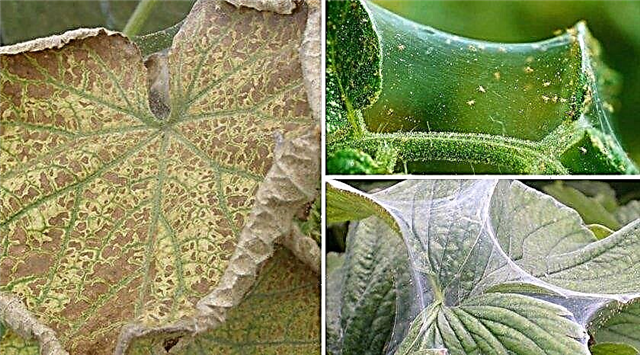 Affected melons gradually turn yellow and die. A thin web also attests to the infection of the plant with a tick. A spider mite settles on the back of the leaves and feeds on their juice.In the case of a massive lesion, the insect forms a light, cobwebble white coating, which is attributed to the characteristic signs of infection. In the absence of special care, infected plants begin to turn yellow, and then wither and die. This negatively affects the harvest, which, not having time to ripen, begins to rot.
Affected melons gradually turn yellow and die. A thin web also attests to the infection of the plant with a tick. A spider mite settles on the back of the leaves and feeds on their juice.In the case of a massive lesion, the insect forms a light, cobwebble white coating, which is attributed to the characteristic signs of infection. In the absence of special care, infected plants begin to turn yellow, and then wither and die. This negatively affects the harvest, which, not having time to ripen, begins to rot.
Broomrape
Infection is one of the most common weed cultures of melon and other Bakhchevs from the same genus of plants. Seeds of this species germinate exclusively in contact with the root system of the desired plant. They form a germ, which is tightly embedded in the root system of the melon and its tissue. Eating juice and other nutrients, broomrape actively develops to the aerial form with numerous sprouts. After flowering, 1 plant can produce up to 100 thousand seeds that can withstand drought, severe frosts and other negative factors.
Important! Broomrape seeds can be stored in the soil for up to 20 years. Even with a successful fight, the parasite can appear in a few years, so you need to start fighting the plant immediately.
It is not difficult to identify broomrape - it is an annual herbaceous species with a height of 10 to 40 cm. The color of the stem of the plant is characteristic, it differs in various shades of brown, yellow, red and blue. During flowering, the parasite forms a spike-shaped apical inflorescence with irregularly shaped flowers of a pale, bluish-purple color. Broomrape parasitism leads to inhibition of melon growth, as well as a decrease in crop quality. Also, the plant helps to reduce the immunity of melons, which provokes the appearance of red rot and other putrefactive pathologies. It is difficult to overcome the parasite, when it is detected, it is necessary to dig out the broomrape with the root system and the host plant before flowering, and then remove it from the site and dispose of it.
Broomrape parasitism leads to inhibition of melon growth, as well as a decrease in crop quality. Also, the plant helps to reduce the immunity of melons, which provokes the appearance of red rot and other putrefactive pathologies. It is difficult to overcome the parasite, when it is detected, it is necessary to dig out the broomrape with the root system and the host plant before flowering, and then remove it from the site and dispose of it.
Gnawing scoops
Two-winged nocturnal insects from the Lepidoptera family belong to scoops. They are small “butterflies” with a wingspan of up to 45 mm and a length of no more than 10 mm, a dark gray shade. During the period of mass reproduction, adults lay eggs in the basal zone of the soil, from which parasitic larvae develop up to 10 mm long. The larvae feed on the juice and tissues of the stem of the melon, which leads to the appearance of characteristic holes on the stem. The caterpillars of this butterfly (they are dirty gray) live in the upper layer of the soil and damage the stalk of the melon, which leads to withering and death of the plant.With massive damage, scoops provoke slow withering of plants, and also cause deterioration in the productivity of the melon and the quality of its crop. To control the larvae, spraying with Volaton and Decis is used. Do such procedures as necessary, but not more than 1 time in 14 days. Additionally, before processing, loosening of beds should be carried out, which increases the effectiveness of insecticides at times.
The caterpillars of this butterfly (they are dirty gray) live in the upper layer of the soil and damage the stalk of the melon, which leads to withering and death of the plant.With massive damage, scoops provoke slow withering of plants, and also cause deterioration in the productivity of the melon and the quality of its crop. To control the larvae, spraying with Volaton and Decis is used. Do such procedures as necessary, but not more than 1 time in 14 days. Additionally, before processing, loosening of beds should be carried out, which increases the effectiveness of insecticides at times.
Preventive actions
Often, all kinds of preventive measures are the main condition for effectively combating any infection and pest. They allow you to create the optimal microclimate, during which the melon will grow most quickly and bear fruit effectively. This directly affects the quality of the fruit, as well as the timing of their ripening, so all sorts of preventive measures when growing melons are a mandatory procedure for care.
In order to prevent these pathologies, you should:
- disinfect the seeds before sowing the melon; for this, they are soaked in 70% alcohol (5–10 minutes) or 2% potassium permanganate (15–20 minutes);
- since autumn, carry out deep plowing of the soil to a depth of at least 30 cm;
- thoroughly clean the soil and site before wintering from the remnants of any vegetation;
- comply with crop rotation rules, melons are grown in the same place only every 3-4 years;
- feed the beds on time;
- create a regulated system of site wetting;
- choose the right place for planting (open and well-lit areas located on a plain or hill, protected from drafts and high humidity);
- at least 1 time per week to carry out weeding and loosening of beds;
- cultivate only high-quality hybrids that have a natural resistance to infections.
Video: growing melon
In addition, you can protect the beds with all kinds of insecticides and fungicides. Against infectious diseases, drugs “Alirin”, “Fitosporin”, “Gamair”, “Planriz” and “Bactofit” will help. As an alternative, 1–2% solutions of copper sulfate or Bordeaux liquid can be used.
The beds can be protected from gnawing parasites by the Fitoverma, Aktofit and Avertin solutions, and Verticillin and Mikoafidin will help from sucking ones. Preventive treatment is carried out periodically (already 2 weeks after germination of the melon) throughout the growing season, with an interval of 3-5 weeks.
Even when cultivating resistant varieties, all kinds of diseases and pests of melon can be found quite often. Often they become the result of non-compliance with the rules of care and culture, which reduces the immunity of plants and creates a favorable microclimate for the development of pathologies. Therefore, when growing melons and gourds, it is imperative to observe the basics of agricultural technology for plant cultivation, as well as always resort to all kinds of preventive treatments.




